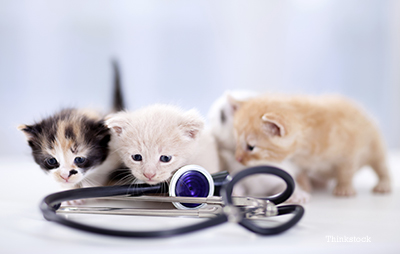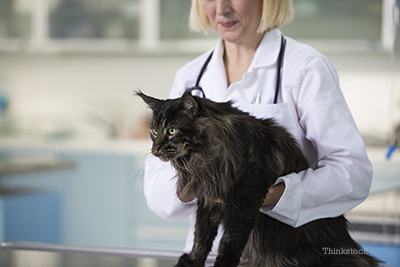
Dr. Phil Zeltzman is a traveling, board-certified surgeon in Allentown, PA. His website is www.DrPhilZeltzman.com. He is the co-author of “Walk a Hound, Lose a Pound” (www.amazon.com).
AJ Debiasse, a technician in Stroudsburg, PA, contributed to this article.
Dr. Marty Becker, “America’s Veterinarian,” has recently started a new trend in U.S. animal hospitals: Fear Free™ veterinary visits. The idea applies to animal clinics, as well as pet guardians interested in “taking the pet out of petrifiedSM.”
In reality, few cats love going to the veterinarian. A typical trip to the hospital can be stressful, for both you and your cat. Stress can cause serious health issues, decrease signs of pain or sensitivity, modify diagnostic tests, weaken the immune system and cause diarrhea. Fortunately, there are now some simple, safe, surefire Fear-Free™ techniques that you and your veterinarian can use to make your cat’s visits to the hospital less stressful.
Reducing stress before the veterinary visit
Stress starts at home. Cats that hide or run away when they see the carrier are afraid because being in the carrier usually means a trip to an unpleasant place like to the veterinary clinic, the groomer or a boarding facility. Make sure your cat gets acclimated to the carrier before visiting your veterinarian. You can even make the carrier a safe, enjoyable place by leaving it out, placing treats inside, spritzing it with pheromones, putting new toys in it and allowing it to be a safe, comfortable place to sleep.
Reducing stress at the veterinarian’s office
Veterinary visits should not be the only time your cat rides in the car. You can take her for a short drive around the block at first, and then progressively increase the distance. Spray some pheromones inside the car (and carrier). This way, over time, your cat will associate traveling with things that are pleasant and will be less fearful of the car. Motion sickness and anxiety can be treated with medications. Your veterinarian can also prescribe tranquilizers (many are natural products), pheromones, anti-nausea drugs, compression garments and even special music. These fear-busting tools can be used alone or together (we call it a multimodal approach) so that nobody fears a trip to the veterinarian.
"Just because" visits to your veterinarian hospital can not only decrease stress, but can help your cat enjoy visits to the veterinarian! Go to the clinic and (after asking for permission) allow your cat to meet friendly faces, enjoy some treats and leave. There should be no poking, no nail trimming and no vaccination. Just fun and treats!
During wellness visits and procedures that don’t require sedation or anesthesia, bring your cat fasted: this can work great. With your veterinarian’s permission, bring your cat’s meal or favorite treats with you. These can be used as a distraction during the exam, vaccines, blood draws etc. Food or treats should be given until the end of the visit. Then petting and a big hug are in order!
Your own demeanor plays a large role in your cat's serenity. Stress is contagious. Your cat trusts you and senses your emotions, so if you're on edge, your cat will be as well. Do your best not to show if you are nervous. Your cat will take cues from you and be on high alert. For example, don’t baby-talk to your cat in the home, in the car or while waiting for the veterinarian. Reducing stress after the veterinary visit
Reducing stress after the veterinary visit
Once you've taken your cat home, for example after surgery, there are simple ways to lessen the stress as well.
When your cat arrives at home, don’t immediately take her out of the carrier. If you have other cats, keep the cat who visited the veterinarian in the carrier for at least an hour. Allow the other cats to smell her and get accustomed to all of the strange smells the cat brought home. Then take a towel and rub the cat from the veterinarian with it; then rub all the other cats with the same towel. This mixing of scents can dramatically decrease tension and fights.
If your cat was sent home with a plastic cone (E-collar), please leave it on. Taking the cone off and putting it back on is not only annoying, but scary. You may think that it’s stressful to wear this device, but it will be far more stressful to go through a skin infection or re-stitching an open incision if your cat licks or chews at the stitches. And you know how rough a cat’s tongue is; it can cause a lot of damage to an incision. Most cats will get used to the cone quickly if you leave it on round the clock.
If your cat is difficult to pill, don’t turn this into a big fight. There are tasty treats you can hide pills in. Some specialized pharmacies can “compound” medications into savory syrup or a tasty treat. Not all compounding pharmacies are created equal, so please ask your veterinarian for advice.
Many cat guardians are just not able to get the medication from the bottle into the cat. Don’t feel embarrassed that you weren’t successful and please don’t just put the medications in the cupboard. Instead, tell your veterinarian. Your veterinarian may be able to:
- Switch your cat to a different medication
- Give your cat the medication for you
- Give your cat a single long-acting injection that can take the place of pills & capsules
Give your cat a chance to rest. Just as you need time to recover after an illness or a procedure, your cat needs time too. The quieter you keep your cat, the quicker the healing will be. Let your cat sleep!
If your cat requires confinement, keep the location consistent. Use the same crate or the same play pen. Switching from a room, when you are home, to a crate, when you are gone, might make your cat feel as if she is being punished. Spend time with your cat in or near the confined area you chose. Your presence will make her feel like she’s still part of the family. Read a book, watch TV or listen to music with her. It may be a much needed break for you as well.
Follow all aftercare instructions as recommended by your veterinarian. These guidelines can help your cat recover more quickly. If no jumping or running is recommended for 8 weeks, then no jumping or running is the rule. Follow-up appointments are not an option. They might include suture removal, bandage changes, follow-up x-rays and progress exams.
We can’t promise that if you follow all of these suggestions, your cat’s experience will be a joy ride. But following these tips will decrease your stress and your cat’s to a much more reasonable level.
Questions you can ask your veterinarian
- Can we arrange a "just because" visit to your clinic?
- What can I do to minimize fear given my cat’s particular situation?
- Can my cat’s medications be compounded?
If you have any questions or concerns, you should always visit or call your veterinarian -- they are your best resource to ensure the health and well-being of your pets.
